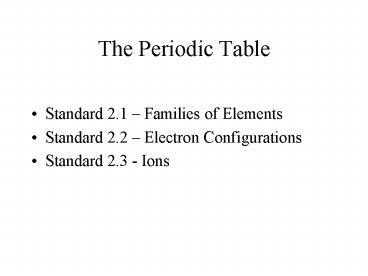The Periodic Table - PowerPoint PPT Presentation
Title:
The Periodic Table
Description:
The Periodic Table Standard 2.1 Families of Elements Standard 2.2 Electron Configurations Standard 2.3 - Ions – PowerPoint PPT presentation
Number of Views:64
Avg rating:3.0/5.0
Title: The Periodic Table
1
The Periodic Table
- Standard 2.1 Families of Elements
- Standard 2.2 Electron Configurations
- Standard 2.3 - Ions
2
Standard 2.1
- Understands how elements are arranged in the
periodic table, and how this arrangement shows
repeating patterns among elements with similar
properties (e.g., numbers of protons, neutrons,
and electrons relation between atomic number and
atomic mass)
3
An atom of magnesium would be the most similar to
_______ in terms of its physical and chemical
properties.
- sodium
- copper
- neon
- barium
- silver
- chromium
4
Select all of the following compounds that would
produce a colorless solution when dissolved in
water?
- AlCl3
- Cu(NO3)2
- MnSO4
- BaI2
- SrCl2
- CoS
5
Which family of metals is the most reactive?
- alkali metals
- alkaline earth metals
- transition metals
- rare earth metals
- halogens
- noble gases
6
Why dont the noble gases react with other
elements? Select all that apply.
- They have the maximum amount of valence
electrons. - They are all gases at room temperature.
- They are already stable.
- They dont have any valence electrons.
- They are very rare.
- They are too unstable.
7
Which of the following best explains why oxygen
has equal numbers of protons and neutrons in its
atoms (8 and 8) while dubnium has 157 neutrons
for only 105 protons?
- Oxygen is a gas and dubnium is a solid.
- Elements with many protons in the nucleus are
unstable and require lots of neutrons to reduce
the pushing force between protons. - Dubnium has many more isotopes than oxygen.
- There is no good explanation. The number of
neutrons in an atom is completely random.
8
Which family of elements does bromine belong to?
- alkali metals
- alkaline earth metals
- halogens
- noble gases
- rare earth metals
- transition metals
9
Select all of the following elements that
represent nonmetals.
- phosphorus
- potassium
- calcium
- hydrogen
- carbon
- uranium
- aluminum
10
Elements in this family have 1 valence electron.
- alkali metals
- alkaline earth metals
- halogens
- noble gases
- rare earth metals
- transition metals
11
Elements in the same period have the same
________.
- number of protons
- number of neutrons
- number of valence electrons
- number of electron rings
- chemical properties
12
Which of the following atoms would be the most
reactive?
- An atom with 2 valence electrons.
- An atom with 3 valence electrons.
- An atom with 4 valence electrons.
- An atom with 5 valence electrons.
- An atom with 6 valence electrons.
- An atom with 7 valence electrons.
- An atom with 8 valence electrons.
13
Participant Scores
14
Racing Leader Board
15
Standard 2.2
- Knows how the electron configuration of atoms
governs the chemical properties of an element as
atoms interact with one another by transferring
or sharing the outermost electrons
16
How many of bromines 35 electrons are found in s
sublevels?
- 0
- 2
- 5
- 6
- 8
- 17
- 30
17
How many orbitals are there in a d sublevel?
- 1
- 2
- 3
- 4
- 5
- 6
- 7
- 10
- 14
18
What sublevels are found in the 3rd energy level
of an atom? Select all that apply.
- s
- p
- d
- f
19
What is the maximum number of electrons for an f
sublevel?
- 1
- 2
- 3
- 5
- 6
- 7
- 8
- 10
- 14
20
In what sublevel will an electron be placed
immediately after the 4s sublevel is filled?
- 2f
- 2d
- 3d
- 4p
- 4d
- 5s
- 5p
- 5d
- 5f
21
Which of the following represents the correct
electron configuration for iron?
- Ar4s23d6
- Kr1s22s22p4
- Ar1s22s22p4
- Ar4s24p6
- Kr3s23d6
- Ar3d6
22
How many valence electrons would an atom with the
following electron configuration
have?1s22s22p63s23p64s23d104p65s24d105p66s24f145d
3
- 1
- 2
- 3
- 4
- 5
- 6
- 7
- 8
23
Participant Scores
15 David Kroncke
15 Hunter Krimmel
12 Austin Fechter
24
Team Scores
14 Team 2
11.67 Team 3
9 Team 1
25
Standard 2.3
- Knows that the number of electrons in an atom
determines whether the atom is electrically
neutral or an ion (i.e., electrically neutral
atoms contain equal numbers of protons and
electrons a positively charged atom has lost one
or more electrons a negatively charged atom has
gained one or more electrons)
26
An atom of mercury containing 79 electrons would
be __________.
- a cation
- an anion
- a neutral atom
27
In order to become stable, an atom of sulfur
would ________ electrons to form a _______
charged ion called ________.
- gain, positively, a cation
- gain, negatively, an anion
- gain, negatively, a cation
- lose, positively, a cation
- lose, negatively, an anion
- lose, positively, an anion
28
Metals typically _______ electrons while
nonmetals typically ______ electrons.
- gain, lose
- lose, gain
29
Which of the following atoms would be
electrically neutral?
- 4 protons, 4 neutrons, 2 electrons
- 23 protons, 25 neutrons, 21 electrons
- 17 protons, 18 neutrons, 18 electrons
- 59 protons, 67 neutrons, 59 electrons
- 51 protons, 58 neutrons, 54 electrons
30
For a carbon atom to become a stable ion, it will
likely ________ electrons.
- gain 2
- lose 2
- gain 4
- lose 4
- gain 6
- lose 6
31
Participant Scores
39 Cody Decker
34 Emily Szczepanski
33 Timothy Grimes

